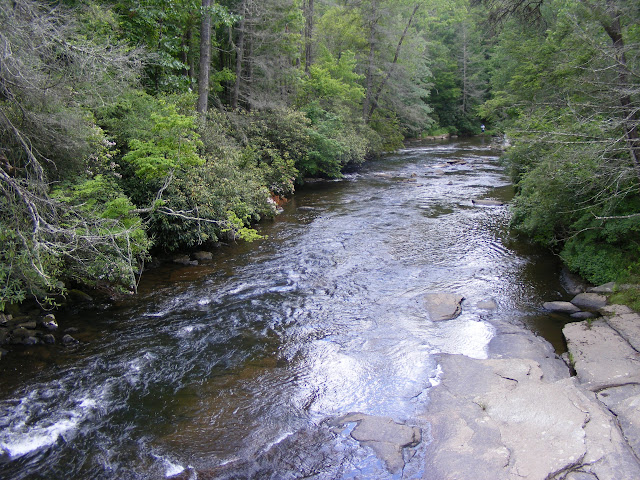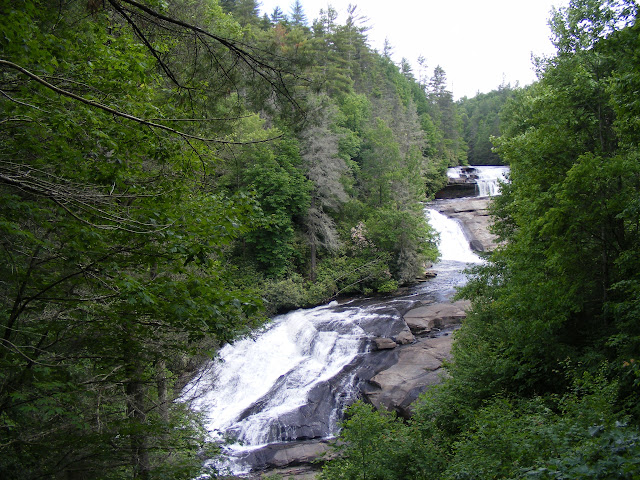Possibly one of my favorite vacations was my family trip to Georgia and North Carolina in June of 2015. I have managed to write the posts for those articles all out of order, of course. There were five major hikes I took, one in Georgia at Line Creek and four in North Carolina. I began with the final hike in Craggy Gardens and proceeded to write the beginning post about Line Creek. This was the fourth hike, the one to Dupont State Forest. It was a sort of addendum after the aptly-titled Graveyard Fields hike (which was a graveyard for our muscles, as one of the more difficult hikes I have taken).
Before I begin, I should probably state that while I've been to the Tetons, Rocky Mountains National Park, Yosemite, Yellowstone, and more National Parks, none have impressed me quite like the Blue Ridge Mountains, and the part I visited was only a National Scenic Roadway. Why? Because, every single moment was unexpected. Everyone knows a lot about Yellowstone, Yosemite, and the Tetons, and I had a distinct impression of how the Rockies would look. Everything lived up to my expectations, except bigger and more awesome. I had no expectations of the Blue Ridge Mountains. I just wanted to go there because there were mountains and a few pretty waterfalls. Even the name is unimpressive. "Blue Ridge Mountains" is a description, not an attraction. I had believed that the main blooming season of spring had been missed, and the assumed-to-be-dominant-understory-plant-from-descriptions-I-read-online of rosebay rhododendron (Rhododendron maximum) bloomed in late June. Sure, there would be a few plants, but most plants would be out of flower and boring, right? And all the native hemlock trees (Tsuga canadensis) were, and are, dying. It would probably be just OK.
I was so, so wrong. I was completely blown away, from the first moment we arrived. The trees were tall and diverse. The forbs were of all sizes, and even more diverse. The area was stunning, and I realized that it was on the border of being a rainforest. It was so green in all shades! Moss grew everywhere, and lichens covered every surface, even leaves in a few areas. Millipedes and snails were everywhere among the moist nonvascular plants. The waterfall above is Looking Glass Falls, one of a dozen waterfalls we saw along the trip. Azaleas of some species are blooming along the cliff above. I had no idea this waterfall existed, and that was one of a thousand things on that trip I did not expect, ranging from snow to orchids. This is all due to the fact that I had not done my research. As resident naturalist in my family, I had been in charge of picking hiking trails, and I had just seen a few and gone with those. How was I to know that the Blue Ridge Mountains are the most floristically biodiverse area in North America? I suppose Google could have told me that, but everyone says Indiana Dunes is the most floristically biodiverse area in temperate North America. (I have swum in Lake Michigan at Indiana Dunes multiple times, but only once have I hiked, without a camera, and the area warrants further exploration.) Anyway, pair flowers with falls and family, and you have a great vacation.
Having come from Graveyard Fields in the Pisgah National Forest, we passed Looking Glass Falls, stopping only briefly. This area is a temperate rainforest according to some estimates, and I won't disagree. Thankfully, it was sunny. If it had been cloudy, driving on the narrow mountain roads would have been more stressful for the driver (who wasn't me, thankfully, and good job Mom and Dad). Bikers enjoyed sneaking up on us around bends in the road.
We spotted what we thought was another cyclist going up the slope on the other side of the road. Then we realized he was missing a wheel. Since when are mountain unicyclists a thing? This guy was riding around on a unicycle on a wet, narrow, unsafe mountain road. The nearby city of Asheville, North Carolina, is called the "Hippie Capitol of the South", but even in California, we never saw anyone this crazy. He wasn't even wearing a helmet. All of us were in such shock that no pictures were taken. There was a river on one side of the road running through a steep ravine, and that was the side he was on. There are some strange people in the world.
After this suprise, we went through the town of Brevard and arrived at Dupont State Forest. This area was around three thousand feet in elevation, and was notable for the plethora of waterfalls. There were many beautiful clear creeks, all flowing rapidly. Mountain Laurel (Kalmia latifolia) bloomed profusely in the woods, with bushes covered in white flowers. Guess what else was blooming in the woods?
Twinberry, or Partrige Berry, (Mitchella repens) is a remarkable plant. There are two species in the genus, with one in eastern Asia and one in eastern North America. (About sixty genera of plants share this peculiarity of only being found in these two separate parts of the world. This is likely due to continental drift theory and similar climate.) The plant produces leaves, flowers, and fruits in pairs, and each flower has four petals. Four is the square root of two. Somebody upstairs was having fun with symmetry when this plant was being designed! Partrige Berry is an occasionally-found plant that can be found in Peoria and Lasalle Counties, as well as the northern, eastern, and southern edges of Illinois. I have seen a large patch of the plants at Starved Rock State Park. However, in the Appalachians, it is far more common, and I had never seen it in flower until this hike.
Here is a patch in flower. This species seems to prefer undisturbed forests. I know for a fact it is quite slow-growing, and thus the occasional custom of using the red berries and evergreen foliage as a Christmas decoration has contributed to its decline. Nevertheless, with a range from Texas to Newfoundland, this species is far from endangered.
So many ferns grew in the area that I lost count of the species. However, I recognize a familiar frond when I see it, and the Christmas Fern (Polystichum acrostichoides) is an old friend. Considering I grow several of these excellent evergreen ferns in my garden, it is a very hardy species.
I presume this fern is the same species, but I do not know for certain. What I do know is that I saw a lot of waterfalls.
This waterfall is Hooker Falls. Isn't that a great name for a clickbait title? Despite the cold water, people were wading at the base of the waterfall. It is evidently a popular swimming hole.
Upstream a species of Iris bloomed across the creek, visible in the center of the picture. This is Iris virginica, one of several species known as blue flag irises.
This area, Triple Falls, was filmed for the first Hunger Games movie. Some fans of those movies may recognize the waterfalls. The big grey dead trees are hemlocks killed by a new invasive species.
I'm not going to get into the whole hemlock problem because it is very depressing. Essentially, the species will soon be extinct south of the Ohio and along the Atlantic coast. Thus, if a new site of the species was to appear in a state where it hadn't been recorded in fifty years, it would be very good for the genetic diversity of the species. (I really have to get back to Starved Rock within the next six months.) Despite the dead trees everywhere, the area was still stunningly beautiful.
Access to the creek valley was allowed, so we strolled out. alongside the falls and examined the area.
This is Allegany Brookfoam (Boykinia aconitifolia), a rare species of wetland plant that is quite possibly one of the closest near-misses of my lifetime. If I hadn't stopped to take a picture of it and kept on walking, it would never have been remembered. This is the only Boykinia species that grows outside of the West.
The waterfalls were impressive up close. We walked along the right edge, and discovered...
Tadpoles! Tadpoles of an unknown species of amphibian swam in the rockpools by the hundreds. We watched them frenetically devour insects and algae. My personal guess is that these are some sort of salamander or treefrog tadpoles, based on the habitat.
Going back into the forest, we saw large colonies of galax (Galax urceolata), an Appalachian endemic and the only member of its genus. This is a plant that can grow in almost no light and it generally grows under the deep shade of pines and evergreen rhododendrons. Galax are harvested for their shiny evergreen leaves, and have died out in some areas due to overcollection. However, this is also one of the most common species in the Blue Ridge Mountains, so it is in little danger. Galax's short stalks of pure white flowers bloomed all over the trails we hiked.
This is one of the most unexpected and wonderous finds of that day. We found moss! Joking aside, the white, chlorophyll- lacking flowers growing out of the moss are one of North America's strangest plants. Indian Pipes (Monotropa uniflora) have no leaves. Except for the flower, they appear like a fungus, ghostly pale on the forest floor... or, in the case of these plants, on the side of a muddy clay embankment which constantly gave out under my feet. I tripped at least twice getting up and down photographing these plants, but it was so worth it. About thirty flowers grew out of the moss, pale and haunting.
Why Indian Pipes are so special is due to one fact... they are parasites on fungi. Essentially, all forests have a dense fungal network under the ground. The fungi involved, known as mycorrhiza, grow into the roots of all the plants in these forests and various nutrients are exchanged between all the plants and all of the fungi.. This process is barely understood and has only been comprehended in the last thirty-odd years. What is easily understood is that Indian Pipe acts as a parasite on the mycorrhiza, stealing nutrients from these fungi. Even this has only been clarified in the last few years. Almost all temperate orchids require this network to grow their seeds, so without the fungi, orchid seeds fail to grow. Part of the reason orchids are so rare in Illinois is that in most places, cultivation has disrupted the fungal network that orchids especially rely on. Similarly, Indian Pipe plants, who seem to only take nutrients from the fungi web, require a lot of fungi. A fungal network strong enough to support Indian Pipe plants is only able to do so if it has been in place for a long time. Therefore, Indian Pipe plants indicate a very healthy forest, as well as the possible presence of orchids in the vicinity. Sadly, there were no orchids I could see in the vicinity. However, there was a beautiful mountain creek...






















No comments:
Post a Comment